The Influence of Typhoon Events on the Design Storm for the Shanghai Metropolitan Area in the Yangtze River Delta, China
Abstract
1. Introduction
2. Materials and Methods
2.1. Study Area and Data
2.2. The Stochastic Storm Transposition (SST) Method
- (1)
- A region including the study area (e.g., A = 4900 km2 shown in Figure 1) is defined as the transposition domain area A’ (e.g., A’ = 494,000 km2 shown in Figure 1), for which the chosen storm catalog area is determined. The transposition domain is usually determined based on a comprehensive analysis of the regional hydro-meteorological and geographical characteristics [52]. The transposition domain of this research is chosen in the middle and lower Yangtze River Basin, as the region shares more similar weather systems, and the main drivers of its extreme rainfall are both landfall typhoons and low-pressure vortices [54,55]. To explore the impact of typhoons on the study area, part of the offshore area was selected for the transposition domain.
- (2)
- The maximum m storms at the t-hour time scale (at least 12 h in the interval between rainfall events) in the transposition domain are selected from the n-year satellite rainfall series to form a subset containing spatial and temporal rainfall data, a “storm catalog”. For the selected storms, to better characterize the storm properties and flood response characteristics of the study area, the m largest storms (m = 200 used in this study) are selected to determine the shape and orientation of the study area. In this study, we have chosen 3, 12, 24, and 72 h as the storm durations to generate four sets of corresponding t-hour storm catalogs. Comparing the central paths and occurrence times of the typhoon events in the CMA-TC, the typhoon events in the storm catalogs are identified.
- (3)
- We randomly select k storms from the storm catalogs following Poisson distribution. The parameter of Poisson distribution is , where there are m storms selected from the n-year radar record. For the storm catalogs in this study, if and , then . For storm transposition, if A’ is a “homogeneous area”, the storm will be transposed under a uniform distribution. When the displacement area A’ is a “heterogeneous area”, that means that there is spatial heterogeneity in the distribution of storms in the area. The probability of storm occurrence and magnitude in different parts of the transposition domain varies. The probability of occurrence of storm events can be determined by the location (longitude and latitude) of m storms, based on the non-parametric estimation method of Gaussian kernel density. A storm in the “heterogeneous area” would be transposed under a non-uniform distribution based on Gaussian kernel density. During the transposition, the motion and evolution of the entire storm field in all periods are not changed, only the spatial location of the storm occurrence (see Figure 2). This paper calculates the frequency of rainfall events based on the premise that the transposition domain is a “heterogeneous area”. After k shifts, the maximum value of t h rainfall accumulation in study area A was retained as the “annual maximum rainfall”.
- (4)
- The above process is repeated N times to construct an “N-year annual maximum storms” sequence with the duration of t h for N years. Note that since the shifted storms are randomly selected from the rainfall catalog, the shifting process is also called “resampling”. Therefore, the cumulative rainfall calculated in the target area A for each resampling process will not be repeated. After resampling, the “annual maximum storms” sequence is obtained for N years. The annual exceedance probability for each instance of rainfall i is , and the recurrence period . The calculation results can be plotted as empirical IDF curves or put into hydrological models.
2.3. Identification of Typhoons
3. Results
3.1. Storm Catalog Analysis
3.1.1. The Magnitude of Storm Events
3.1.2. The Occurrence of Storm Events
3.1.3. The Spatial Distribution of Storm Events
3.2. The Typhoon Events
3.2.1. The Occurrence of Typhoon Events
3.2.2. The Spatial Distribution of Typhoon Events
3.2.3. The Characteristics of Selected Typhoon Events
3.3. SST-Based Frequency Analysis
3.3.1. IDF Estimated Value
3.3.2. The Temporal Process of the SST-Based Design Storm
3.3.3. The Spatial Structure of the SST-Based Design Storm
4. Discussion
4.1. The Uncertainties of the SST Method
4.2. The Impact of Typhoon Rainfall on the SST Estimation Results
5. Conclusions
Author Contributions
Funding
Data Availability Statement
Conflicts of Interest
Appendix A
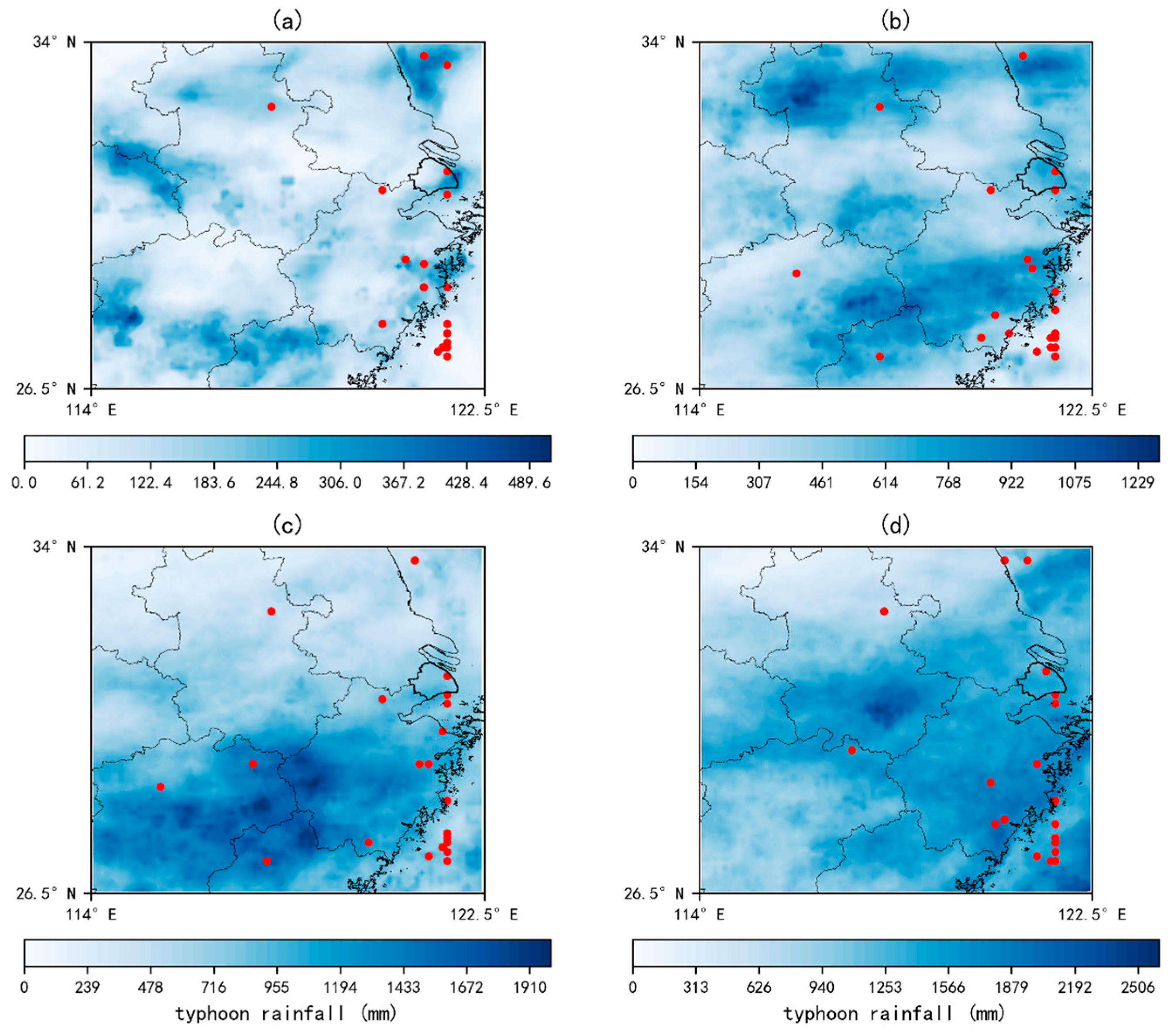
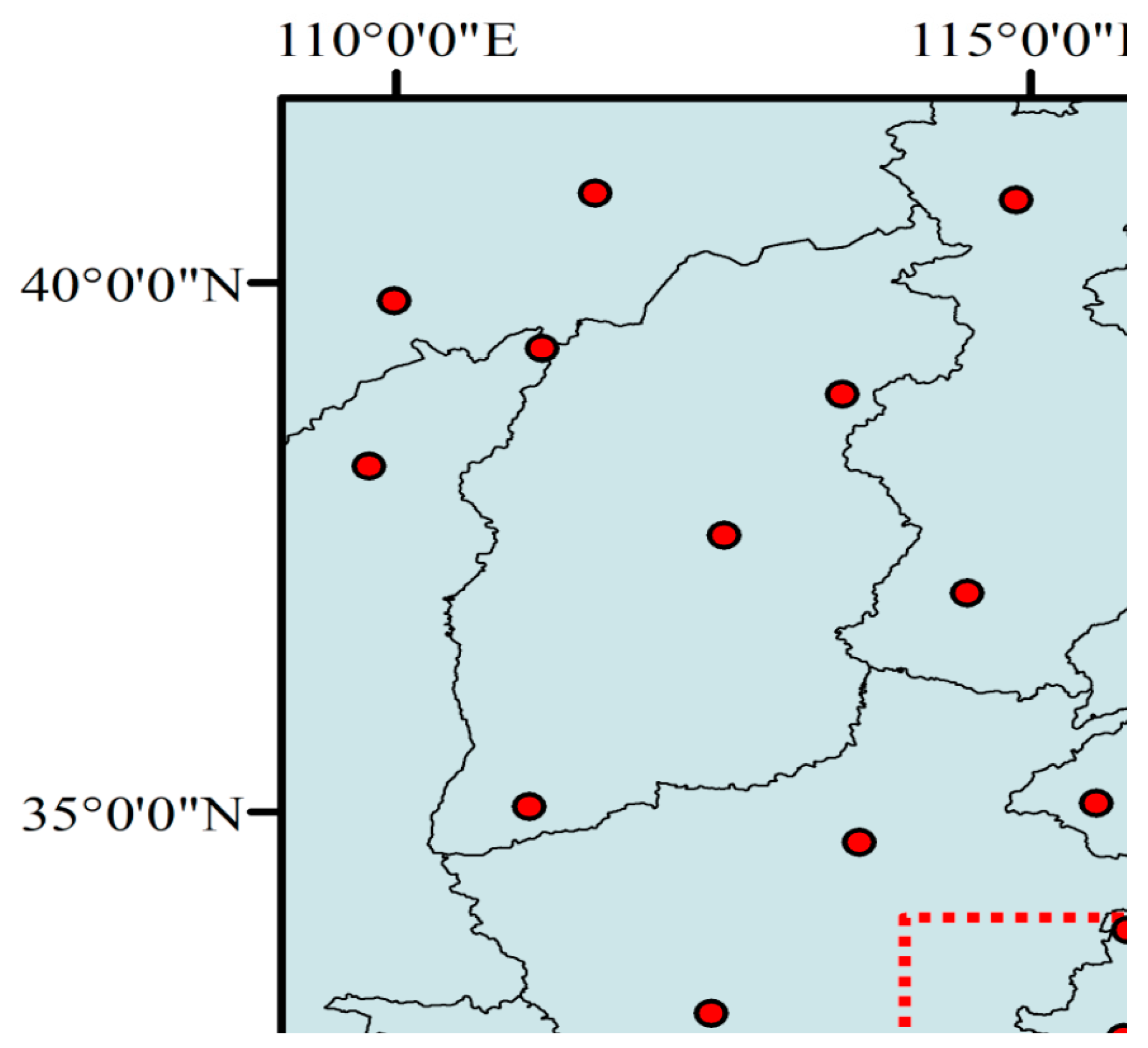
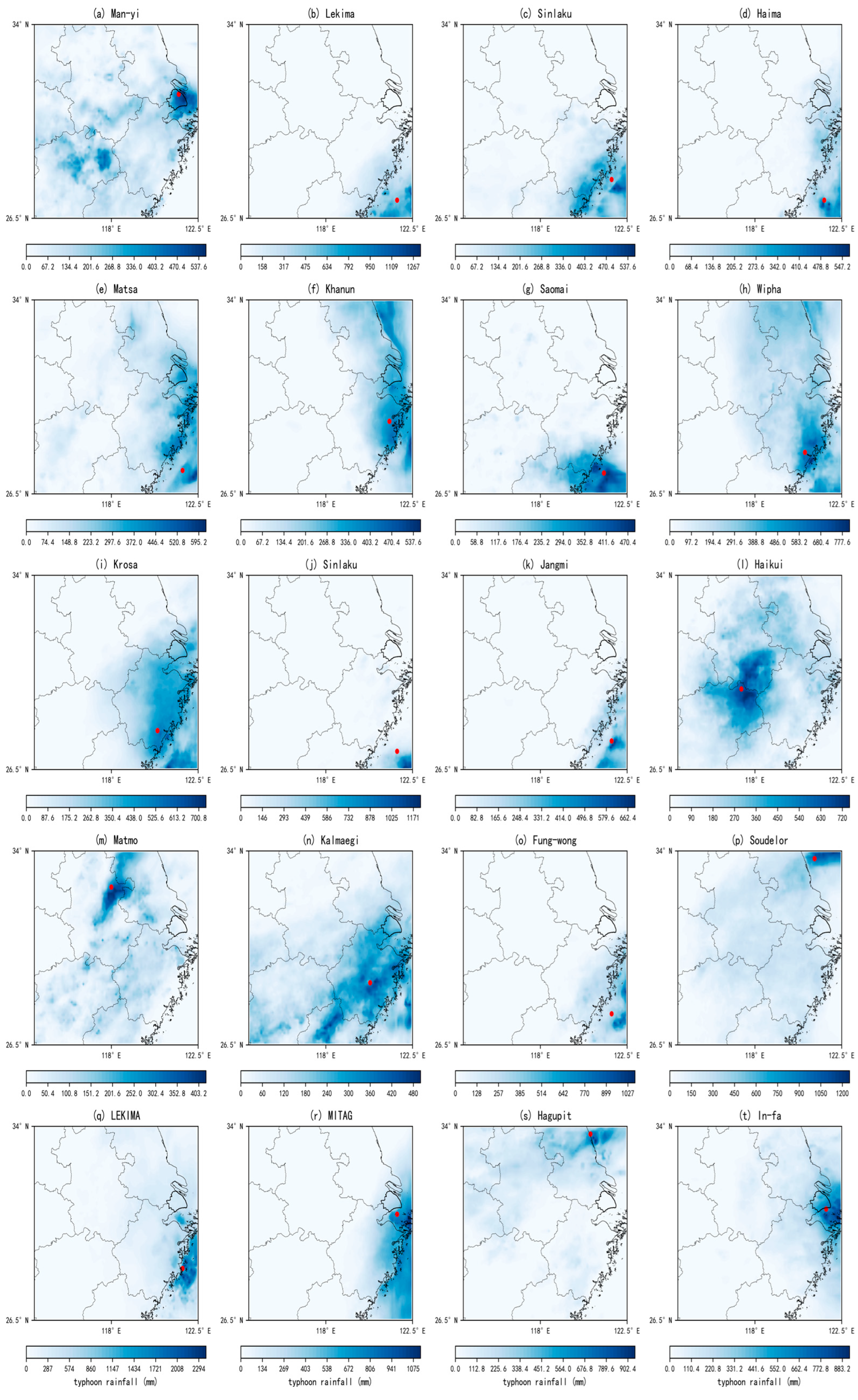
References
- Allan, R.P.; Soden, B.J. Atmospheric warming and the amplification of precipitation extremes. Science 2008, 321, 1481–1484. [Google Scholar] [CrossRef]
- Alexander, L.V.; Zhang, X.; Peterson, T.C.; Caesar, J.; Gleason, B.; Tank, A.; Haylock, M.; Collins, D.; Trewin, B.; Rahimzadeh, F.; et al. Global observed changes in daily climate extremes of temperature and precipitation. J. Geophys. Res.-Atmos. 2006, 111. [Google Scholar] [CrossRef]
- Trenberth, K.E. Changes in precipitation with climate change. Clim. Res. 2011, 47, 123–138. [Google Scholar] [CrossRef]
- Chow, V.T. Handbook of Applied Hydrology; McGraw-Hill: New York, NY, USA, 1964. [Google Scholar]
- Paschalis, A.; Fatichi, S.; Molnar, P.; Rimkus, S.; Burlando, P. On the effects of small scale space-time variability of rainfall on basin flood response. J. Hydrol. 2014, 514, 313–327. [Google Scholar] [CrossRef]
- Emmanuel, I.; Andrieu, H.; Leblois, E.; Janey, N.; Payrastre, O. Influence of rainfall spatial variability on rainfall-runoff modelling: Benefit of a simulation approach? J. Hydrol. 2015, 531, 337–348. [Google Scholar] [CrossRef]
- Arnaud, P.; Bouvier, C.; Cisneros, L.; Dominguez, R. Influence of rainfall spatial variability on flood prediction. J. Hydrol. 2002, 260, 216–230. [Google Scholar]
- Tang, G.Q.; Ma, Y.Z.; Long, D.; Zhong, L.Z.; Hong, Y. Evaluation of GPM Day-1 IMERG and TMPA Version-7 legacy products over Mainland China at multiple spatiotemporal scales. J. Hydrol. 2016, 533, 152–167. [Google Scholar] [CrossRef]
- Skofronick-Jackson, G.; Petersen, W.A.; Berg, W.; Kidd, C.; Stocker, E.F.; Kirschbaum, D.B.; Kakar, R.; Braun, S.A.; Huffman, G.J.; Iguchi, T.; et al. The global precipitation measurement (gpm) mission for science and society. Bull. Am. Meteorol. Soc. 2017, 98, 1679–1695. [Google Scholar] [CrossRef]
- Hou, A.Y.; Kakar, R.K.; Neeck, S.; Azarbarzin, A.A.; Kummerow, C.D.; Kojima, M.; Oki, R.; Nakamura, K.; Iguchi, T. The global precipitation measurement mission. Bull. Am. Meteorol. Soc. 2014, 95, 701–722. [Google Scholar] [CrossRef]
- Ebert, E.E.; Janowiak, J.E.; Kidd, C. Comparison of near-real-time precipitation estimates from satellite observations and numerical models. Bull. Am. Meteorol. Soc. 2007, 88, 47–64. [Google Scholar] [CrossRef]
- Wright, D.B.; Yu, G.; England, J.F. Six decades of rainfall and flood frequency analysis using stochastic storm transposition: Review, progress, and prospects. J. Hydrol. 2020, 585, 124816. [Google Scholar] [CrossRef]
- Alexander, G. Application of probability to spillway design flood estimation. In Proceedings of the Leningrad Symposium on Floods and Their Computation, August 1967; International Association of Scientific Hydrology. 1969. Available online: https://unesdoc.unesco.org/ark:/48223/pf0000014623 (accessed on 30 April 2023).
- Yu, G.; Wright, D.B.; Li, Z. The Upper Tail of Precipitation in Convection-Permitting Regional Climate Models and Their Utility in Nonstationary Rainfall and Flood Frequency Analysis. Earth’s Future 2020, 8, e2020EF001613. [Google Scholar] [CrossRef]
- Wright, D.B.; Smith, J.A.; Baeck, M.L. Flood frequency analysis using radar rainfall fields and stochastic storm transposition. Water Resour. Res. 2014, 50, 1592–1615. [Google Scholar] [CrossRef]
- Gao, S.; Fang, Z. Using Storm Transposition to Investigate the Relationships between Hydrologic Responses and Spatial Moments of Catchment Rainfall. Nat. Hazards Rev. 2018, 19, 04018015. [Google Scholar] [CrossRef]
- Wright, D.B.; Smith, J.A.; Villarini, G.; Baeck, M.L. Estimating the frequency of extreme rainfall using weather radar and stochastic storm transposition. J. Hydrol. 2013, 488, 150–165. [Google Scholar] [CrossRef]
- Zhu, Z.; Wright, D.B.; Yu, G. The Impact of Rainfall Space-Time Structure in Flood Frequency Analysis. Water Resour. Res. 2018, 54, 8983–8998. [Google Scholar] [CrossRef]
- Zhou, Z.; Smith, J.A.; Wright, D.B.; Baeck, M.L.; Yang, L.; Liu, S. Storm Catalog-Based Analysis of Rainfall Heterogeneity and Frequency in a Complex Terrain. Water Resour. Res. 2019, 55, 1871–1889. [Google Scholar] [CrossRef]
- Zhou, Z.; Smith, J.A.; Baeck, M.L.; Wright, D.B.; Smith, B.K.; Liu, S. The impact of the spatiotemporal structure of rainfall on flood frequency over a small urban watershed: An approach coupling stochastic storm transposition and hydrologic modeling. Hydrol. Earth Syst. Sci. 2021, 25, 4701–4717. [Google Scholar] [CrossRef]
- Zhuang, Q.; Zhou, Z.; Liu, S.; Wright, D.B.; Araruna Junior, J.T.; Makhinov, A.N.; Makhinova, A.F. Bivariate rainfall frequency analysis in an urban Watershed: Combining copula theory with stochastic storm transposition. J. Hydrol. 2022, 615, 128648. [Google Scholar] [CrossRef]
- van Oldenborgh, G.J.; van der Wiel, K.; Sebastian, A.; Singh, R.; Arrighi, J.; Otto, F.; Haustein, K.; Li, S.; Vecchi, G.; Cullen, H. Attribution of extreme rainfall from Hurricane Harvey, August 2017. Environ. Res. Lett. 2017, 12, 124009. [Google Scholar] [CrossRef]
- Bhatia, K.; Baker, A.; Yang, W.C.; Vecchi, G.; Knutson, T.; Murakami, H.; Kossin, J.; Hodges, K.; Dixon, K.; Bronselaer, B.; et al. A potential explanation for the global increase in tropical cyclone rapid intensification. Nat. Commun. 2022, 13, 6626. [Google Scholar] [CrossRef]
- Knutson, T.R.; Sirutis, J.J.; Zhao, M.; Tuleya, R.E.; Bender, M.; Vecchi, G.A.; Villarini, G.; Chavas, D. Global Projections of Intense Tropical Cyclone Activity for the Late Twenty-First Century from Dynamical Downscaling of CMIP5/RCP4. 5 Scenarios. J. Clim. 2015, 28, 7203–7224. [Google Scholar] [CrossRef]
- Wu, L.G.; Zhao, H.K.; Wang, C.; Cao, J.; Liang, J. Understanding of the Effect of Climate Change on Tropical Cyclone Intensity: A Review. Adv. Atmos. Sci. 2022, 39, 205–221. [Google Scholar] [CrossRef]
- Ho, C.H.; Baik, J.J.; Kim, J.H.; Gong, D.Y.; Sui, C.H. Interdecadal changes in summertime typhoon tracks. J. Clim. 2004, 17, 1767–1776. [Google Scholar] [CrossRef]
- Emanuel, K. Tropical cyclones. Annu. Rev. Earth Planet. Sci. 2003, 31, 75–104. [Google Scholar] [CrossRef]
- Knutson, T.; Camargo, S.J.; Chan, J.C.L.; Emanuel, K.; Ho, C.H.; Kossin, J.; Mohapatra, M.; Satoh, M.; Sugi, M.; Walsh, K.; et al. Tropical Cyclones and Climate Change Assessment: Part II: Projected Response to Anthropogenic Warming. Bull. Am. Meteorol. Soc. 2020, 101, E303–E322. [Google Scholar] [CrossRef]
- Kossin, J.P.; Knapp, K.R.; Olander, T.L.; Velden, C.S. Global increase in major tropical cyclone exceedance probability over the past four decades. Proc. Natl. Acad. Sci. USA 2020, 117, 11975–11980. [Google Scholar] [CrossRef] [PubMed]
- Islam, S.; Villarini, G.; Zhang, W. Quantification of the role of urbanization in changing the rainfall associated with tropical cyclones affecting Charlotte, North Carolina. Urban Clim. 2023, 52, 101681. [Google Scholar] [CrossRef]
- Chen, J.; Yang, K.; Liu, L.; Li, B. Impact of 60 years land use change on rainfall-runoff in central shanghai. J. Nat. Resour. 2010, 25, 914–925. [Google Scholar]
- Liu, X.; Zou, L.; Xia, L. Analysis on the Characteristics and Reason of Heavy Rain and Strong Wind in Shanghai Caused by Typhoon Krosa. Meteorol. Mon. 2008, 34, 72–78. [Google Scholar]
- Liang, P.; Ding, Y.-H.; He, J.-H.; Tang, X. Study of relationship between urbanization speed and change in spatial distribution of rainfall over shanghai. J. Trop. Meteorol. 2013, 19, 97–103. [Google Scholar]
- Zhuang, Q.; Liu, S.G.; Zhou, Z.Z. Spatial Heterogeneity Analysis of Short-Duration Extreme Rainfall Events in Megacities in China. Water 2020, 12, 3364. [Google Scholar] [CrossRef]
- Zhuang, Q.; Liu, S.; Zhou, Z. The change of spatio-temporal precipitation and rainfall frequency analysis in shanghai. J. China Hydrol. 2021, 41, 74–80. [Google Scholar]
- Yang, L.; Smith, J.A.; Wright, D.B.; Baeck, M.L.; Villarini, G.; Tian, F.Q.; Hu, H.P. Urbanization and Climate Change: An Examination of Nonstationarities in Urban Flooding. J. Hydrometeorol. 2013, 14, 1791–1809. [Google Scholar] [CrossRef]
- Bloeschl, G.; Hall, J.; Viglione, A.; Perdigao, R.A.P.; Parajka, J.; Merz, B.; Lun, D.; Arheimer, B.; Aronica, G.T.; Bilibashi, A.; et al. Changing climate both increases and decreases European river floods. Nature 2019, 573, 108–111. [Google Scholar] [CrossRef] [PubMed]
- Wang, J.; Dai, J.; Yang, Y.; Lv, Y. Statistical analysis of the characteristics of typhoons in China from 1977 to 2018. Trans. Oceanol. Limnol. 2021, 43, 28–33. [Google Scholar]
- Fang, G.; Gao, Y.; Xu, L.; Hu, L.; Zhang, S. Analysis of precipitation change and the characteristics of disaster rainfalls in shanghai. Resour. Environ. Yangtze Basin 2012, 21, 1270–1273. [Google Scholar]
- Zong, Y.Q.; Chen, X.Q. Typhoon hazards in the Shanghai area. Disasters 1999, 23, 66–80. [Google Scholar] [CrossRef]
- Shi, J.; Xiao, F.; Mu, H.; Xu, J. Losses assessment of typhoon disaster in shanghai during 1949-2009. Resour. Environ. Yangtze Basin 2013, 22, 952–957. [Google Scholar]
- Wang, J.; Gao, W.; Xu, S.; Yu, L. Evaluation of the combined risk of sea level rise, land subsidence, and storm surges on the coastal areas of Shanghai, China. Clim. Chang. 2012, 115, 537–558. [Google Scholar] [CrossRef]
- Wang, Y.; Chen, A.S.; Fu, G.; Djordjevic, S.; Zhang, C.; Savic, D.A. An integrated framework for high-resolution urban flood modelling considering multiple information sources and urban features. Environ. Model. Softw. 2018, 107, 85–95. [Google Scholar] [CrossRef]
- Li, Y.; Chen, L.; Lei, X. Numerical study on impacts of upper-level westerly trough on the extratropical transition process of typhoon Winnie (1997). Acta Meteorol. Sin. 2006, 64, 552–563. [Google Scholar]
- Xiang, S.; Zhou, M.; Xu, Y.; Du, J. The Characteristics of typhoon “Lekima” and the cause of extreme rainfall. Mar. Forecast. 2020, 37, 76–85. [Google Scholar]
- Xu, X.; Liu, J.; Zhang, Z.; Zhou, W.; Zhang, S.; Li, R.; Yan, C.; Wu, S.; Shi, X. Time Series of Land Ecosystem Classification Dataset of China in Five-Year Increments. Digit. J. Glob. Chang. Data Repos. 2015. [Google Scholar] [CrossRef]
- Xu, X.; Liu, J.; Zhang, Z.; Zhou, W.; Zhang, S.; Li, R.; Yan, C.; Wu, S.; Shi, X. A Time Series Land Ecosystem Classification Dataset of China in Five-Year Increments (1990–2010). J. Glob. Chang. Data Discov. 2017, 1, 52–59. [Google Scholar] [CrossRef]
- Kazamias, A.-P.; Sapountzis, M.; Lagouvardos, K. Evaluation of GPM-IMERG rainfall estimates at multiple temporal and spatial scales over Greece. Atmos. Res. 2022, 269, 106014. [Google Scholar] [CrossRef]
- Li, P.; Xu, Z.X.; Ye, C.L.; Ren, M.F.; Chen, H.; Wang, J.J.; Song, S.L. Assessment on IMERG V06 Precipitation Products Using Rain Gauge Data in Jinan City, Shandong Province, China. Remote Sens. 2021, 13, 1241. [Google Scholar] [CrossRef]
- Ying, M.; Zhang, W.; Yu, H.; Lu, X.; Feng, J.; Fan, Y.; Zhu, Y.; Chen, D. An Overview of the China Meteorological Administration Tropical Cyclone Database. J. Atmos. Ocean. Technol. 2014, 31, 287–301. [Google Scholar] [CrossRef]
- Lu, X.; Yu, H.; Ying, M.; Zhao, B.; Zhang, S.; Lin, L.; Bai, L.; Wan, R. Western North Pacific Tropical Cyclone Database Created by the China Meteorological Administration. Adv. Atmos. Sci. 2021, 38, 690–699. [Google Scholar] [CrossRef]
- Wright, D.B.; Mantilla, R.; Peters-Lidard, C.D. A remote sensing-based tool for assessing rainfall-driven hazards. Environ. Model. Softw. 2017, 90, 34–54. [Google Scholar] [CrossRef]
- Zhengzheng, Z.; Shuguang, L.; Wright, D.B. Analysis of urban design storm based on stochastic storm transposition. Adv. Water Sci. 2020, 31, 583–591. [Google Scholar]
- Xiao, M.; Zhang, Q.; Singh, V.P. Influences of ENSO, NAO, IOD and PDO on seasonal precipitation regimes in the Yangtze River basin, China. Int. J. Climatol. 2015, 35, 3556–3567. [Google Scholar] [CrossRef]
- Tang, Y.; Huang, A.N.; Wu, P.L.; Huang, D.Q.; Xue, D.K.; Wu, Y. Drivers of Summer Extreme Precipitation Events Over East China. Geophys. Res. Lett 2021, 48, e2021GL093670. [Google Scholar] [CrossRef]
- Zhang, Q.A.; Wu, L.G.; Liu, Q.F. Tropical cyclone damages in China 1983-2006. Bull. Am. Meteorol. Soc. 2009, 90, 489–496. [Google Scholar] [CrossRef]
- Wu, L.G.; Wang, B.; Geng, S.Q. Growing typhoon influence on east Asia. Geophys. Res. Lett. 2005, 32. [Google Scholar] [CrossRef]
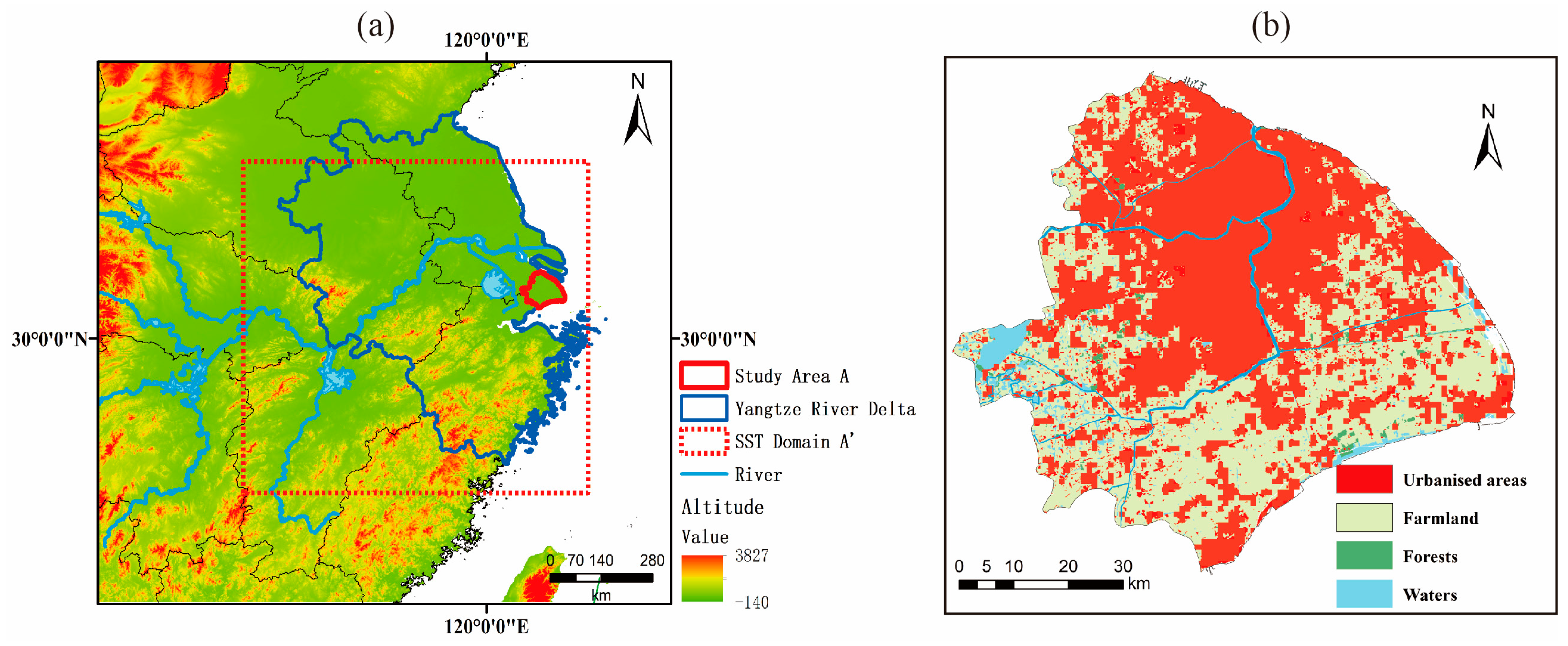
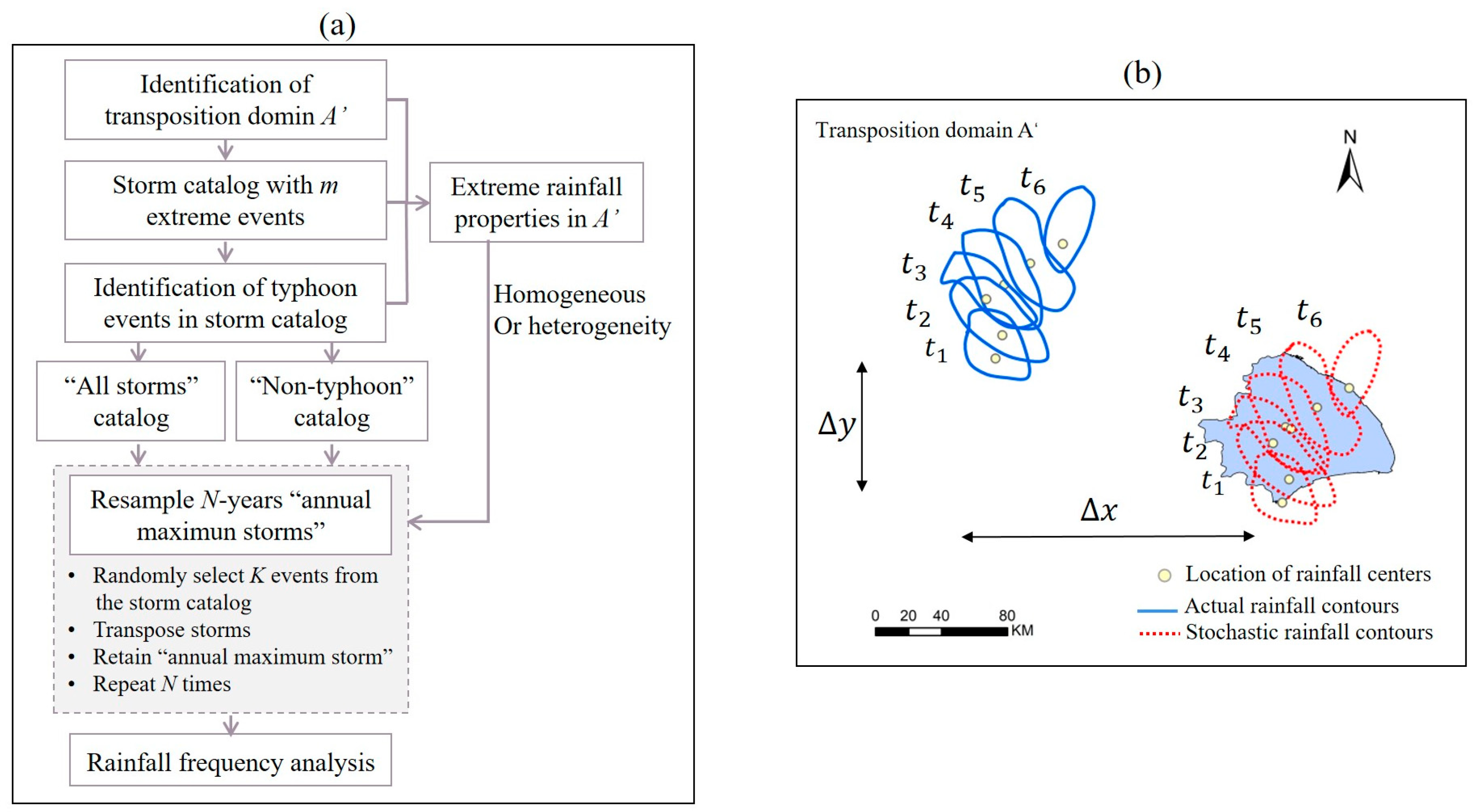
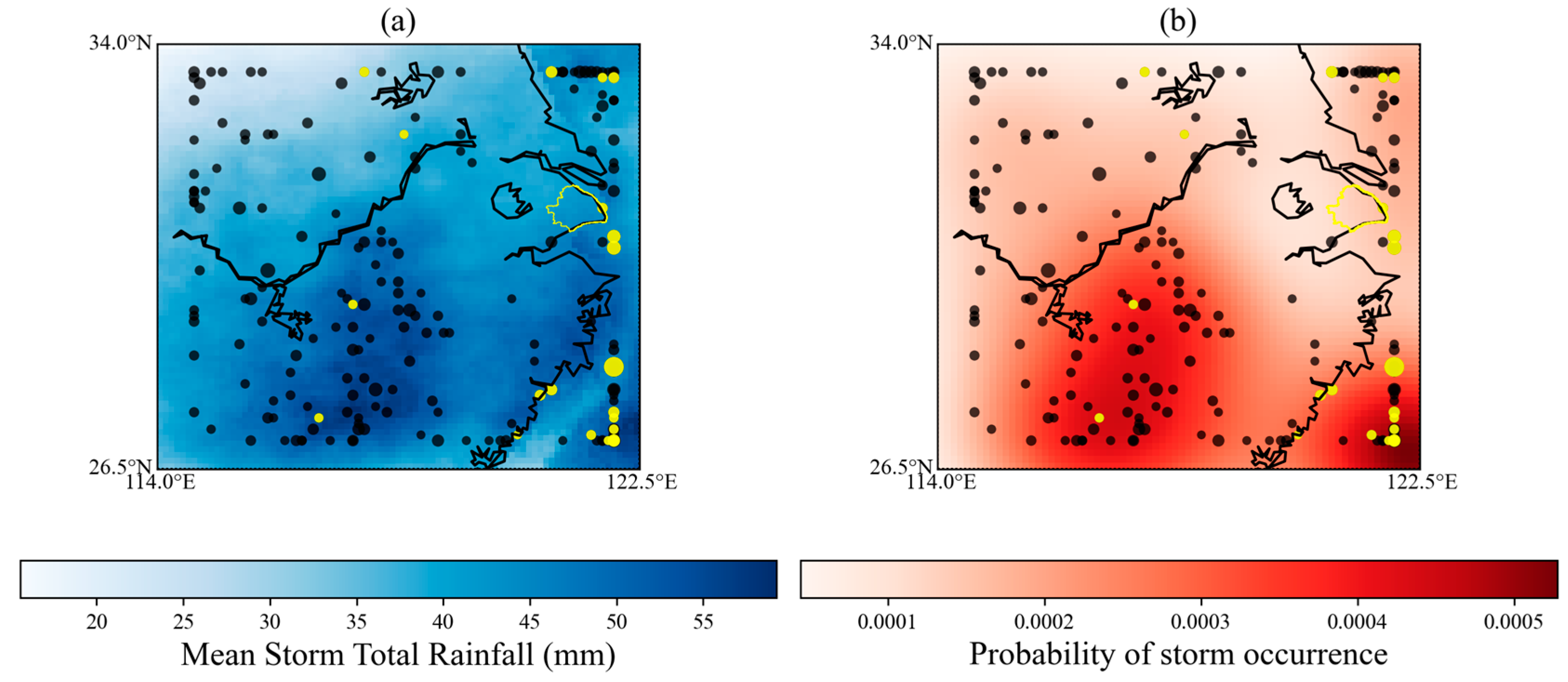
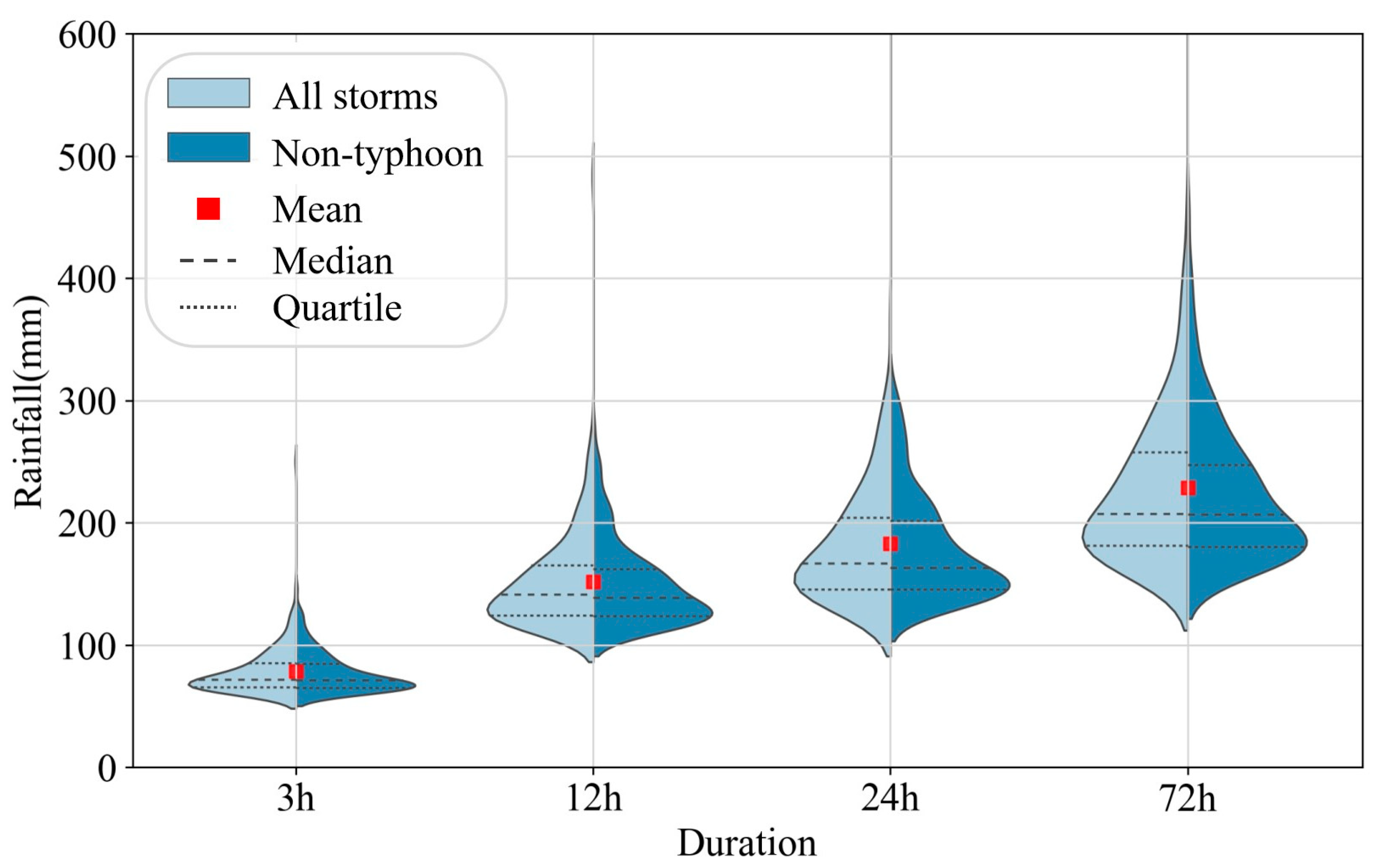
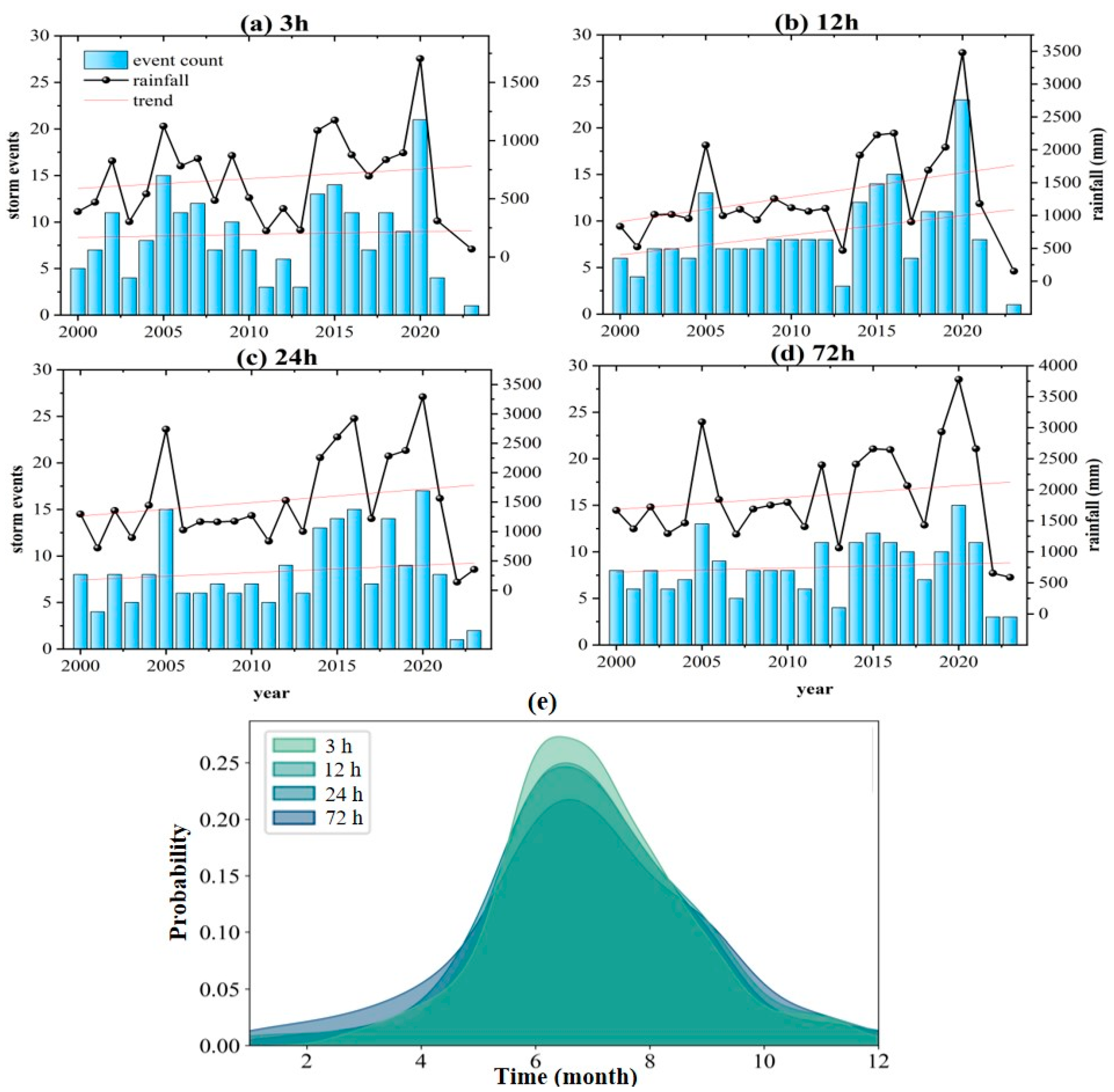
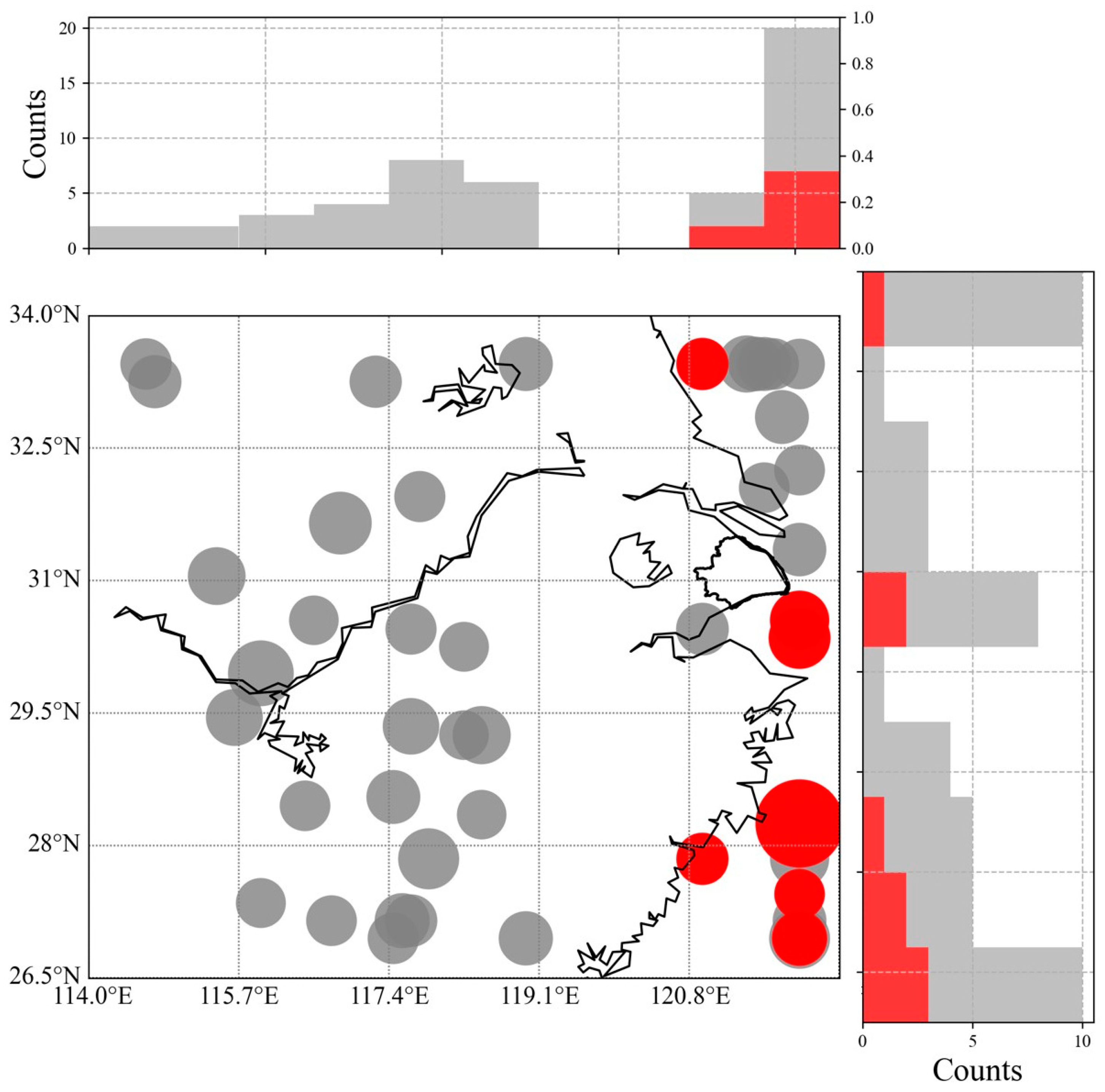
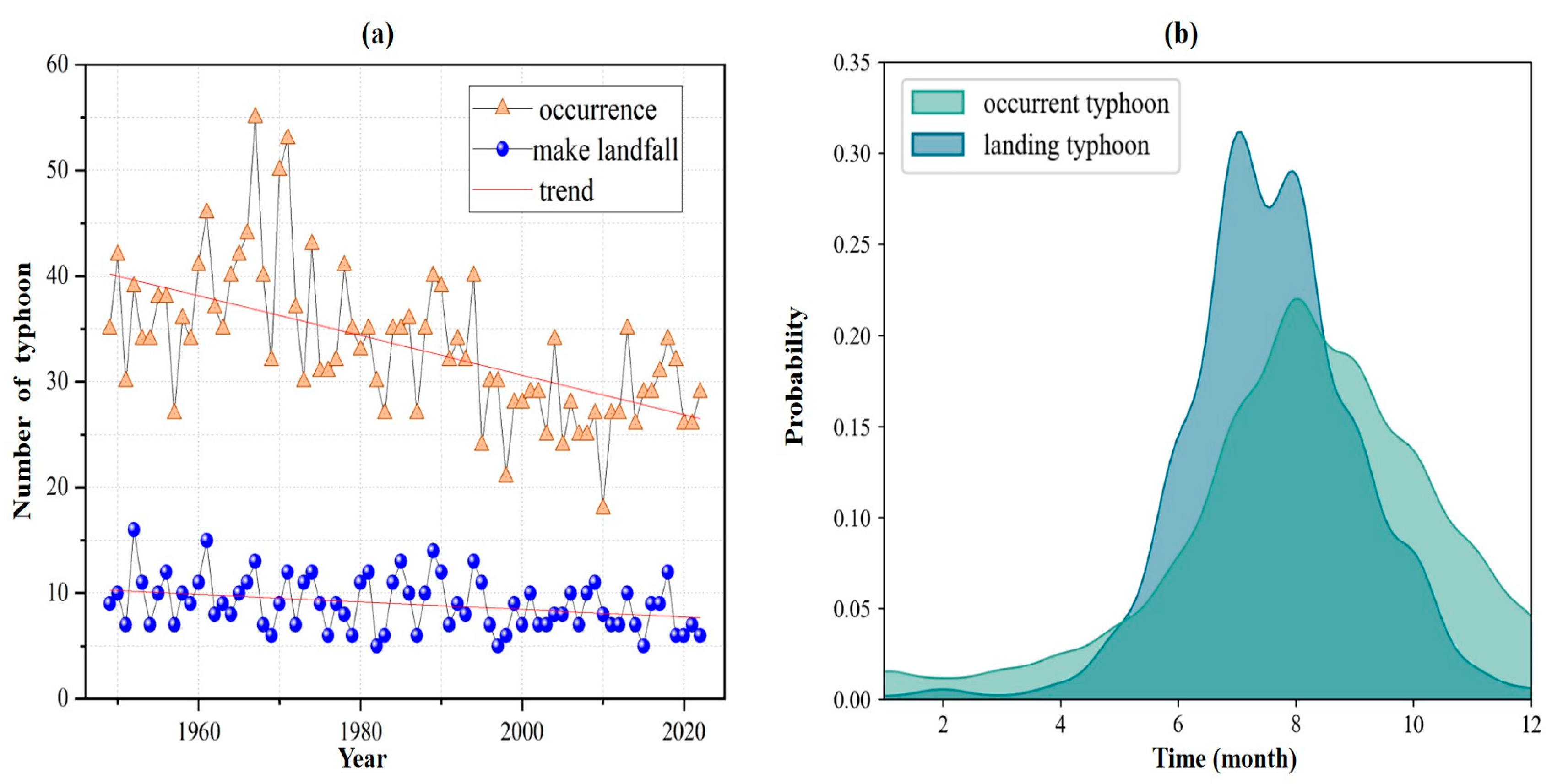
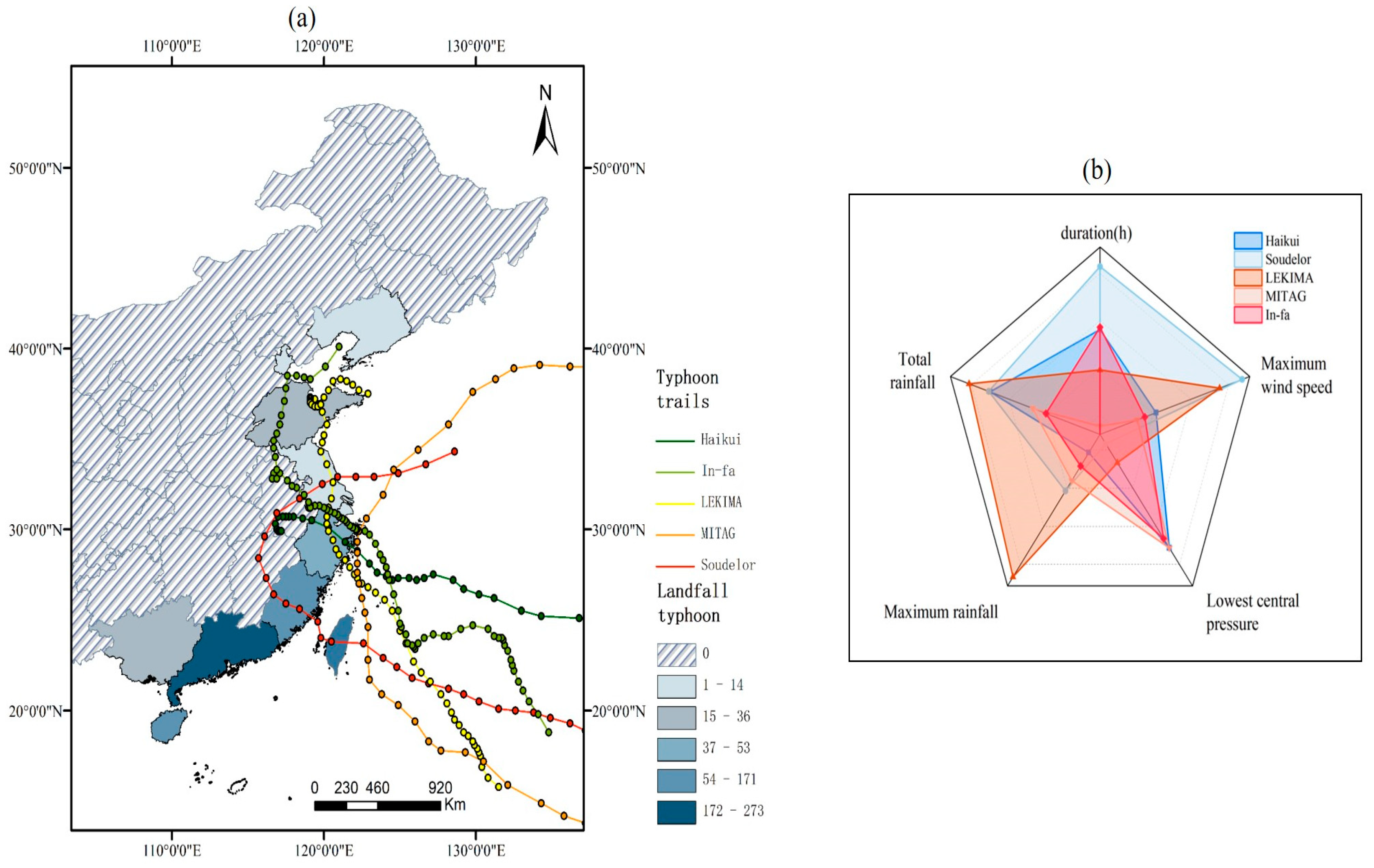

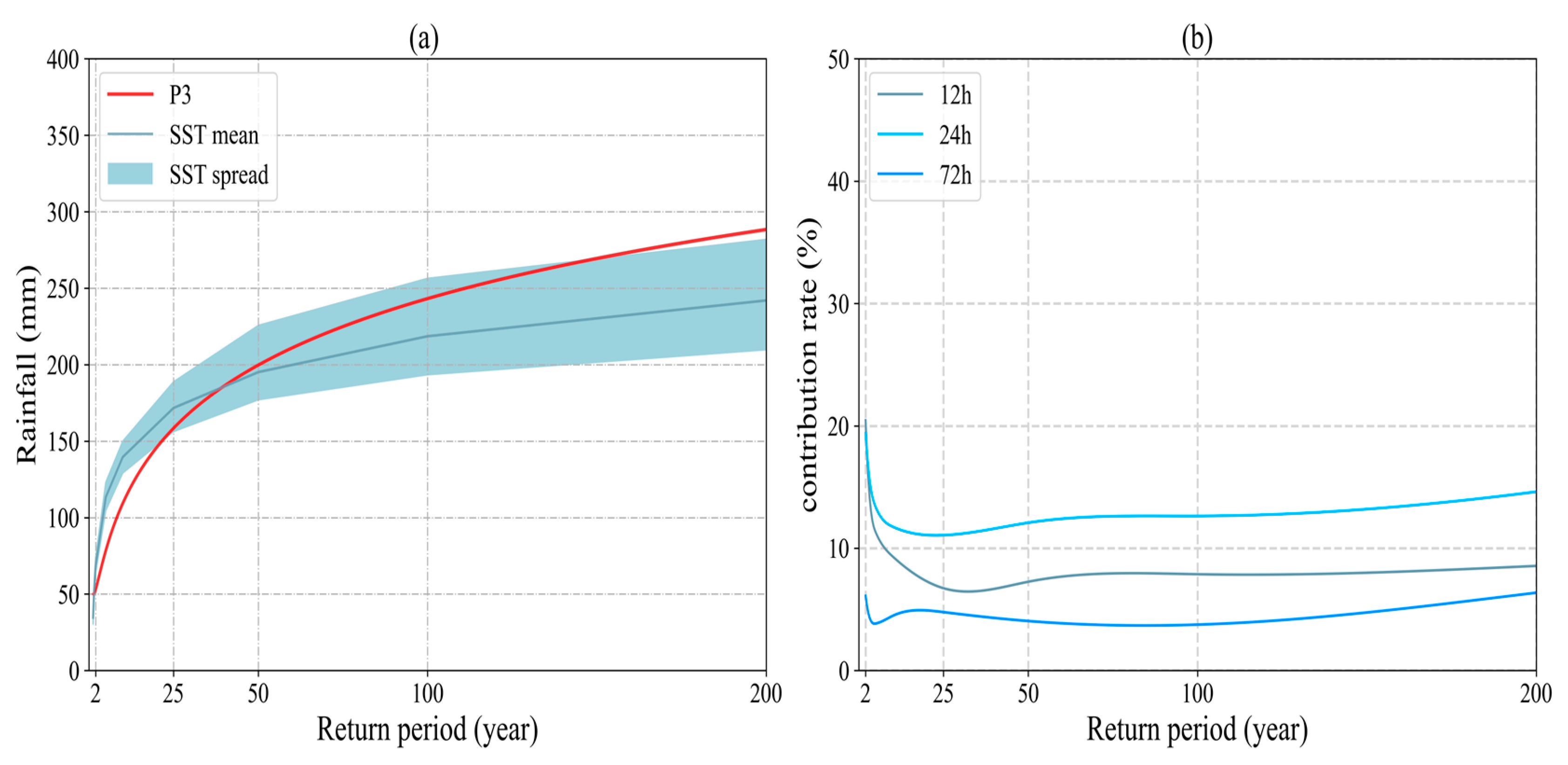
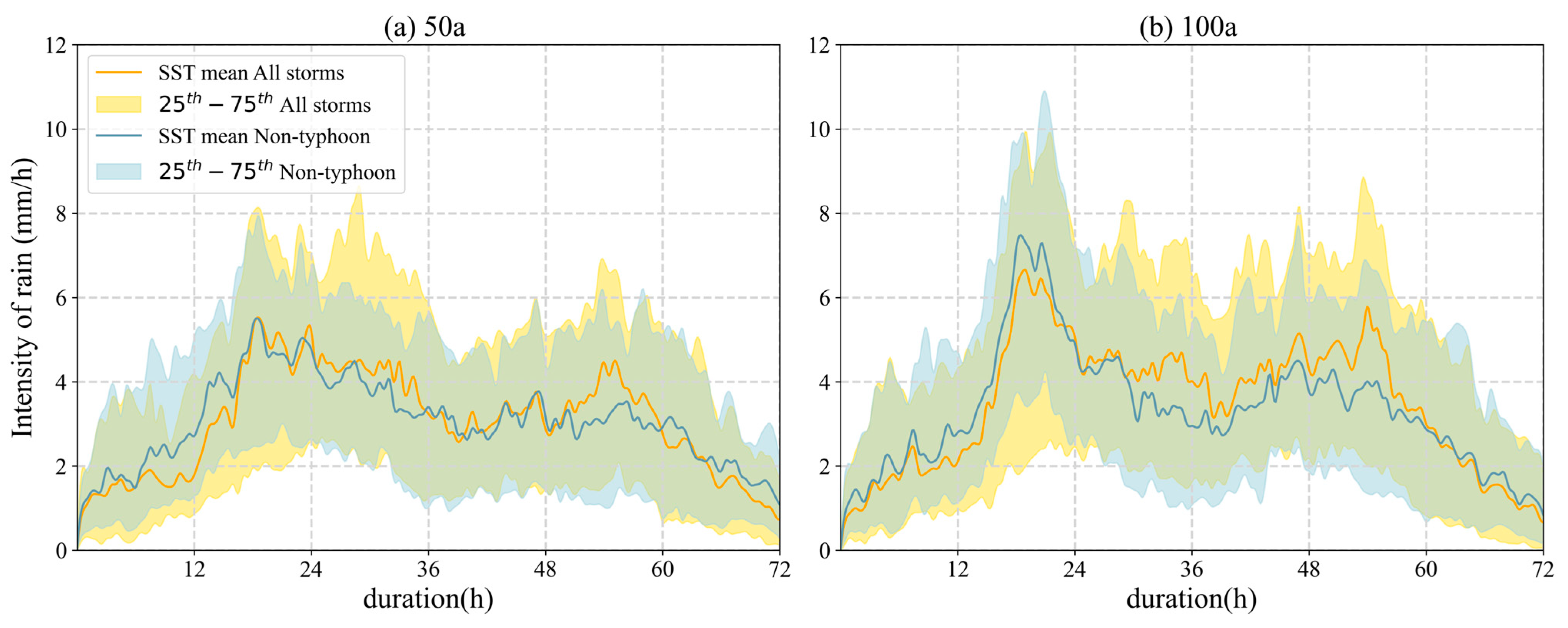
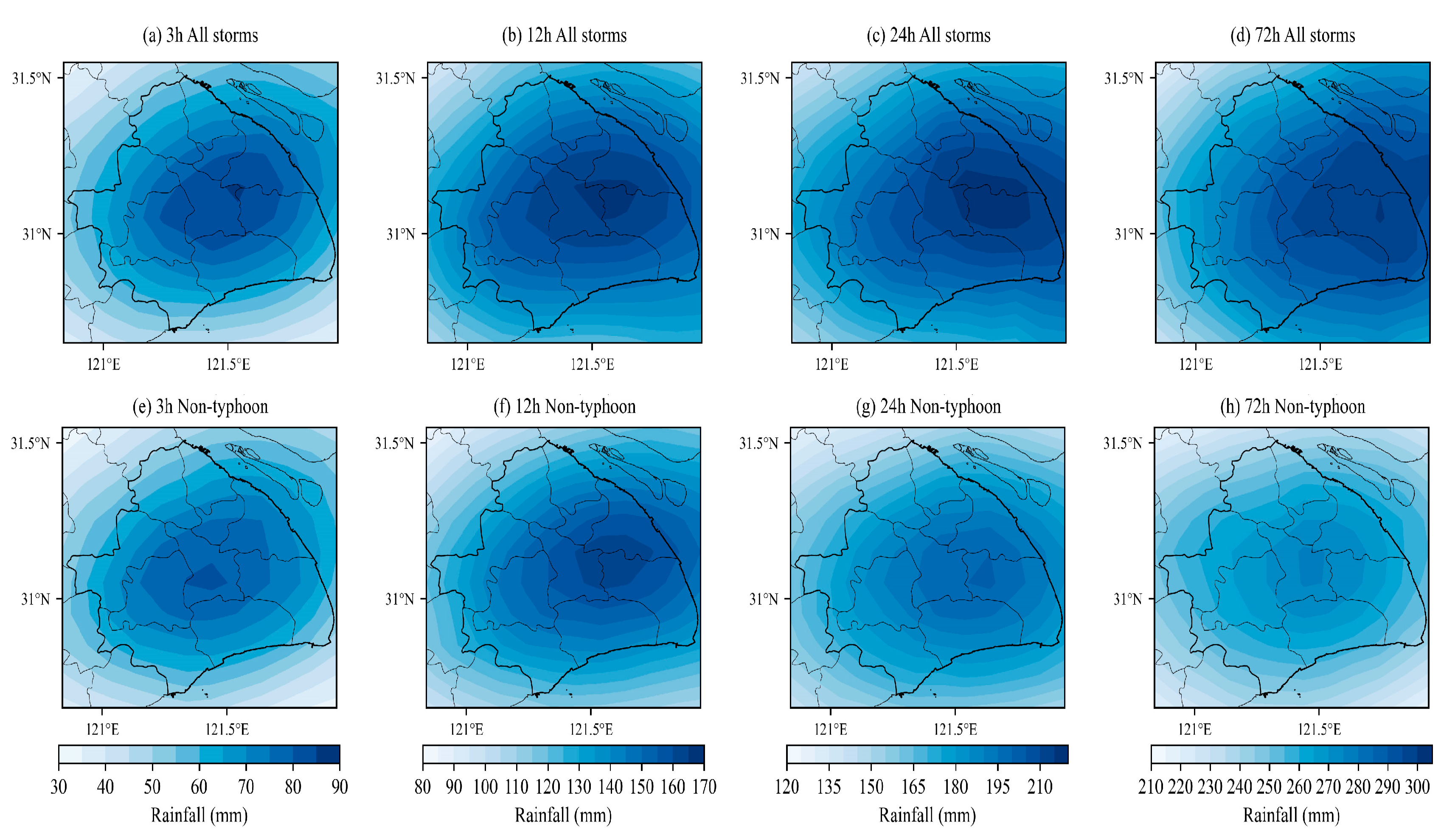
| Duration | Number of Detected Typhoons | Percentage |
|---|---|---|
| 3 h | 20 | 10% |
| 12 h | 23 | 11.5% |
| 24 h | 24 | 12% |
| 72 h | 20 | 10% |
| Typhoon Name | Date (yy-mm-dd) | Cv | Typhoon Name | Date (yy-mm-dd) | Cv |
|---|---|---|---|---|---|
| Man-yi | 2001-08-01 | 0.997 | Jangmi | 2008-09-23 | 3.186 |
| Lekima | 2001-09-21 | 2.770 | Haikui | 2012-08-01 | 0.933 |
| Sinlaku | 2002-08-28 | 1.941 | Matmo | 2014-07-17 | 1.155 |
| Haima | 2004-09-10 | 2.246 | Kalmaegi | 2014-08-18 | 0.894 |
| Matsa | 2005-07-30 | 1.210 | Fung-wong | 2014-09-17 | 2.582 |
| Khanun | 2005-09-05 | 1.506 | Soudelor | 2015-07-30 | 0.881 |
| Saomai | 2006-08-05 | 2.223 | LEKIMA | 2019-08-03 | 1.582 |
| Wipha | 2007-09-15 | 1.012 | MITAG | 2019-09-27 | 2.058 |
| Krosa | 2007-10-01 | 1.364 | Hagupit | 2020-07-31 | 1.286 |
| Sinlaku | 2008-09-08 | 4.073 | In-fa | 2021-07-16 | 1.601 |
| Duration | Catalog Type | Return Period | |||||||
|---|---|---|---|---|---|---|---|---|---|
| 5 a | 10 a | 25 a | 50 a | 100 a | 200 a | 500 a | 1000 a | ||
| 3-h | All storms | 0.0499 | 0.0445 | 0.0419 | 0.0316 | 0.0437 | 0.0570 | 0.0785 | 0.1927 |
| Non-typhoon | 0.0542 | 0.0479 | 0.0450 | 0.0343 | 0.0414 | 0.0543 | 0.0660 | 0.0953 | |
| 12-h | All storms | 0.0414 | 0.0342 | 0.0315 | 0.0326 | 0.0402 | 0.0539 | 0.0752 | 0.1737 |
| Non-typhoon | 0.0473 | 0.0357 | 0.0348 | 0.0341 | 0.0411 | 0.0525 | 0.0723 | 0.0944 | |
| 24-h | All storms | 0.0325 | 0.0278 | 0.0269 | 0.0356 | 0.0444 | 0.0609 | 0.0821 | 0.3005 |
| Non-typhoon | 0.0334 | 0.0295 | 0.0297 | 0.0307 | 0.0391 | 0.0505 | 0.0636 | 0.0789 | |
| 72-h | All storms | 0.0202 | 0.0173 | 0.0233 | 0.0329 | 0.0376 | 0.0520 | 0.0782 | 0.1935 |
| Non-typhoon | 0.0210 | 0.0178 | 0.0210 | 0.0331 | 0.0390 | 0.0446 | 0.0613 | 0.0789 | |
Disclaimer/Publisher’s Note: The statements, opinions and data contained in all publications are solely those of the individual author(s) and contributor(s) and not of MDPI and/or the editor(s). MDPI and/or the editor(s) disclaim responsibility for any injury to people or property resulting from any ideas, methods, instructions or products referred to in the content. |
© 2024 by the authors. Licensee MDPI, Basel, Switzerland. This article is an open access article distributed under the terms and conditions of the Creative Commons Attribution (CC BY) license (https://creativecommons.org/licenses/by/4.0/).
Share and Cite
Jin, Y.; Liu, S.; Zhou, Z.; Zhuang, Q.; Liu, M. The Influence of Typhoon Events on the Design Storm for the Shanghai Metropolitan Area in the Yangtze River Delta, China. Water 2024, 16, 508. https://doi.org/10.3390/w16030508
Jin Y, Liu S, Zhou Z, Zhuang Q, Liu M. The Influence of Typhoon Events on the Design Storm for the Shanghai Metropolitan Area in the Yangtze River Delta, China. Water. 2024; 16(3):508. https://doi.org/10.3390/w16030508
Chicago/Turabian StyleJin, Yuting, Shuguang Liu, Zhengzheng Zhou, Qi Zhuang, and Min Liu. 2024. "The Influence of Typhoon Events on the Design Storm for the Shanghai Metropolitan Area in the Yangtze River Delta, China" Water 16, no. 3: 508. https://doi.org/10.3390/w16030508
APA StyleJin, Y., Liu, S., Zhou, Z., Zhuang, Q., & Liu, M. (2024). The Influence of Typhoon Events on the Design Storm for the Shanghai Metropolitan Area in the Yangtze River Delta, China. Water, 16(3), 508. https://doi.org/10.3390/w16030508






